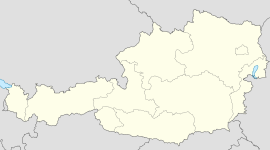- Obernberg am Brenner
-
Obernberg am Brenner Country Austria State Tyrol District Innsbruck Land Mayor Peter Jenewein Area 38.66 km2 (15 sq mi) Elevation 1,380 m (4528 ft) Population 364 (1 January 2011)[1] - Density 9 /km² (24 /sq mi) Time zone CET/CEST (UTC+1/+2) Licence plate IL Postal code 6156 Area code 05274 Website www.obernberg.tirol.gv.at Coordinates: 47°00′59″N 11°25′10″E / 47.01639°N 11.41944°E
Obernberg am Brenner is a municipality in the southern Innsbruck-Land District, Tirol with a population of 360 (2010), an area of 38,66 square kilometres at an elevation of 1380 metres.[2]
Contents
Geography
Obernberg am Brenner is located nearly 30 km south from Innsbruck in a Valley, with the same name, which depart from the west side of Wipptal at Gries am Brenner. The valley has end with the massif of Schwarze Wand and the group of the Tribolaum. The popular Obernberger See is visited by tourists; the Obernberger Seebach flows through the village and provides Obernberg with drinking water.
Hamlets
Außerthal, Eben, Frade, Gereit, Leite, Innerthal.
History
Coat-of-arms
Obernberg coat-of-arm is a red shield with three golden skittles. According to a legend the miners, at that time, were so rich to play with true golden skittles. [3]
Origin
The valley was already inhabited since the Bronze Age and was used as pasture; the romans occupied the place in the 15 BC. Later were opened mining to extract gold, silver, copper and lead which remained active until the sixteenth century, and these were owned by the Bishops of Brixen until 1490 when they passed to the Principality of Tirol. In a 1238 document appeared the name “Padreins” while “Obernberg” is mentioned for the first time approximately in 1300, until then it was called “Vinaders”. The nearby villages of the Wippatal, as St. Leonhard, St. Jodok and Gries am Brenner, drew development from the mining activities as on their territories were foundries and warehouses. Around in 1560, with the advent of the imports of precious metals from the new world, the mines and the stock yards closed. A Chapel in Romanesque style, built by miners, dedicated to St. Nikolaus is mentioned in a document dated to 1339. In the fifteeth century, because of the growing population, the chapel was extended and the choir was built in Giothic style. Until 1758 the chapel depended on Matrei am Brenner, than had its own Curate and on the same site, under the direction of Franz de Paula Penz, a new baroque church was built; in 1891 it was elevated to Parish. [4]
References
- ^ Statistik Austria - Bevölkerung zu Jahres- und Quartalsanfang, 2011-01-01.
- ^ Statistik austria
- ^ Tyrol
- ^ Geschichte Tirol
External links
Absam · Aldrans · Ampass · Axams · Baumkirchen · Birgitz · Ellbögen · Flaurling · Fritzens · Fulpmes · Gnadenwald · Götzens · Gries am Brenner · Gries im Sellrain · Grinzens · Gschnitz · Hall in Tirol · Hatting · Inzing · Kematen in Tirol · Kolsass · Kolsassberg · Lans · Leutasch · Matrei am Brenner · Mieders · Mils · Mühlbachl · Mutters · Natters · Navis · Neustift im Stubaital · Oberhofen im Inntal · Obernberg am Brenner · Oberperfuss · Patsch · Pettnau · Pfaffenhofen · Pfons · Polling in Tirol · Ranggen · Reith bei Seefeld · Rinn · Rum · Sankt Sigmund im Sellrain · Scharnitz · Schmirn · Schönberg im Stubaital · Seefeld in Tirol · Sellrain · Sistrans · Steinach am Brenner · Telfes · Telfs · Thaur · Trins · Tulfes · Unterperfuss · Vals · Volders · Völs · Wattenberg · Wattens · Wildermieming · Zirl
Categories:- Cities and towns in Tyrol
- Tyrol geography stubs
Wikimedia Foundation. 2010.



